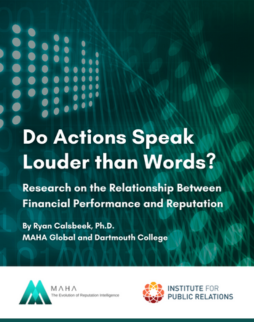
In partnership with PR Daily, “How We Did It” is a series featuring IPR Trustees discussing a success in their public relations career.
Early in my career as a research-based communications consultant, few people talked about public relations research and evaluation. I assumed that everyone talked about research; they simply didn’t want to talk with me about it.
Then in a conversation with an agency CEO, he commented: “We don’t measure at all. I’d gladly forgo being a proven success in exchange for never being a proven failure.”
That was my PR research “aha” moment.
I viewed research as an impartial guide used to improve performance. The PR community viewed research as a pass/fail report card to prove value.
I wasn’t wrong, I was early. The desire to prove value and improve performance are always present and interrelated but the profession focused—and continues to focus—on “proving PR value.” The solution was further complicated because “values” are subjective: values towards PR change not just from one organization to another but from one person to another within the same organization.
This reality forged the “executive audit,” a brief, anonymous survey conducted with a small group of senior executives with a focus on PR funding, objectives-setting and performance evaluation.
The purpose of this research was twofold:
- To assess current performance, to refine PR’s understanding with executives by eliminating barriers and gaining the feedback required to manage expectations, and then to exceed them;
- To initiate and formalize the dialogue for setting objectives, determining the measures of success and for deploying programs destined to deliver on shared preferences for what is meaningful, measurable and reasonable.
The key elements measured throughout the study included:
- Executives’ perceptions of organizational priorities and PR’s ability to deliver on these priorities
- Preferred measures and the extent to which PR delivers (outputs and outcomes)
- Preferences for communication of results (frequency, KPIs, etc.)
Prioritization and performance against target media, influencers and journalists
Once the surveys were completed, PR representatives negotiated any gaps between the executives’ preferences for “what’s meaningful” with PR’s understanding of “what’s reasonable.”
After roughly 10,000 interviews with executives at the full range of organizational types (for-profit and not-for-profit; international and domestic; large and small; etc.) executive preferences for the PR success measures which combine their desire for what’s meaningful, measurable and reasonable are almost predictable:
Aggregating anonymous opinions enables the communicator to bring executive outliers to the center (to reconcile with the exec who hates the media with the one who loves the exposure). Delivering on four common objectives is much easier than navigating to deliver on 40 individual preferences. With regular reporting reflecting the consensus priorities, executives gain confidence that PR delivers value on terms which are pre-negotiated, agreed and authorized.
To meet the profession’s desire to prove PR value while improving PR performance, the executive audit empowers professional communicators to set smarter objectives, develop better strategy, execute more effective campaigns, and deliver results in the language executives prefer.
![]()
 Mark Weiner is chief insights officer for Cision and CEO of PRIME Research. He is a member of the Arthur Page Society and a board member of the Institute for Public Relations.
Mark Weiner is chief insights officer for Cision and CEO of PRIME Research. He is a member of the Arthur Page Society and a board member of the Institute for Public Relations.



